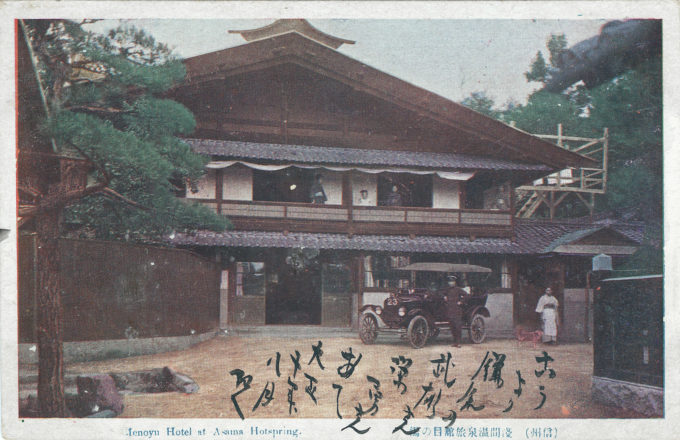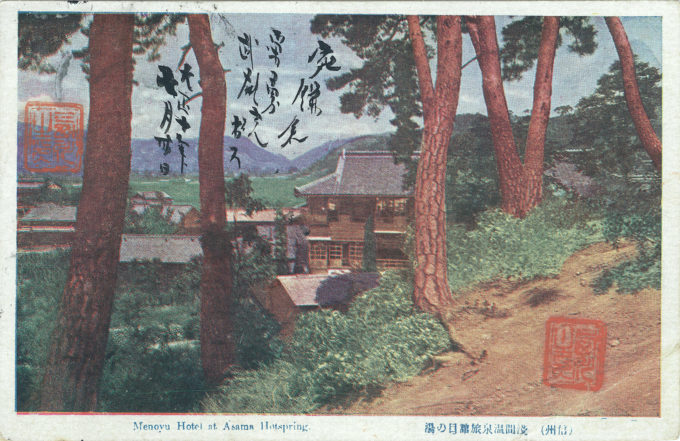
Menoyu Ryokan, Asama Onsen, Matsumoto, c. 1930. The current Menoyu web site notes that the ryokan is in its eighth generation of family operation, and that the original 240-year old structure (above) which remains dates back to its original purpose as a sericulture (silk growing) facility.
“Rather than stop at Matsumoto, those in search of pure air and the picturesque should repair to the spruce little vill. of Asama, 30 cho to the N.E., noted for its hot springs. Of the numerous inns, the best is the Me-no-yu.”
– A Handbook for Travellers in Japan, by Basil Hall Chamberlain & W.B. Mason, 1901

Menoyu Ryokan, Asama Onsen, Matsumoto, c. 1930. The hot springs water contains boric acid, the origin of the name “Menoyu” [“eye bath”] as a hot spring that benefits the eyes.
“Asama is situated on the edge of a large plain, Matsumoto-daira, 1,600 ft. above sea level. The Metoba-gawa river is just below the spa, which, being near one of the gateways to the Japan Alps, is a desirable place for an overnight stay on a mountain-climbing excursion, the approach to the mountains being made by motorbus from Matsumoto.
“Five simple thermal springs, 13 m. away, temp. 50° C. 122° F. at the source, supply the baths at Asama. They have been known since 947. Salt is the predominating chemical constituent. The water is of most benefit for the diseases named for this class of springs on p. 23.
“From Asama, the foot-hills of part of the Alps rise dark toward the west, beyond the Azusa and Narai Rivers. Above them tower the first spurs. Higher still the snow-clad summits glow in the sunset gold.
“Railway: From Tokyo, Chū-ō Main Line (Iidamachi station) to Matsumoto, 152.4 mls. (10:23 hrs.) – 2nd cl., ¥6.62. O , from Ueno station via Shin-Etsu Line to Shinonoi, thence by Shinonoi Line to Matsumoto – 162.5 mls. ( 9-1/2; hrs. ); 2nd cl., ¥6.96.
“Conveyance: About 2 m., Matsumoto to Asama – motor bus, 50 sen; rickisha, 70 sen, private motor car (6 pass.), ¥3.”
– The Hot Springs of Japan (and Principal Cold Mineral Springs), Japan Government Railways, 1922


Pingback: Ikaya Ryokan, Naoetsu, Niigata Prefecture, c. 1910. | Old Tokyo
Pingback: Yoshinoya Ryokan, Kaga Yamanaka Onsen, Ishikawa Prefecture, c. 1930. | Old Tokyo